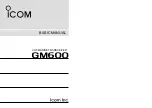
Technalogix Ltd
Adrenaline Control System
VI-11
Reflected RF power level in % out of 100 or watts. Mimics data from level bar.
The high VSWR fault occurs when the measured VSWR of the system exceeds
the user-defined VSWR trip point found in the RF Power Menu, described later in
this section. If the VSWR exceeds the user defined shutdown level, but is below
1.8:1, then attenuation is added to the power amplifier input until a safe level is
reached. If the measured VSWR exceeds 1.8:1, then the RF carrier is turned off
to protect the amplifier chain. At this point, the system will continually check to
see if it is safe to come back on. This protection scheme helps ensure that the
system stays on the air as long as possible before doing a complete shutdown. If
high reflected power occurs, a warning is also displayed in red text near the top
of the touchscreen and the event recorder logs the event.
Temperature from sensor mounted on heat sink surface. Shutdown trip point is
factory set at a predetermined level to keep the amplifier pallets safe. Should a
fan fail inside the power amplifier enclosure, or air conditioning fails inside the
broadcast facility causing the temperature to exceed the trip point, the control
system will lower forward RF power until a safe level of measured temperature is
achieved. The system will continually try and bring the RF power back to the
same level when the fault occurred if it is safe to do so, a warning is displayed in
red text near the top of the touchscreen, and the event recorder logs the event.
RF output power is determined largely in part by the amount of attenuation that
the control system places on the input of the power amplifier. Whether a fault
occurs and attenuation gets added or the user requests a change in RF power
level via the web/SNMP/Remote Port interface, the attenuation section of the
summary bar conveys important operating information. If the user requests a
change in forward power level via the web interface, SNMP monitoring and
control, or simply via the Remote Port connector on the back of the enclosure,
and an asterisk (*) is placed next to the attenuation value in the summary bar.
This informs the user whether or not the attenuation was added due to a fault or
simply because it was requested.
Automatic Gain Control or Manual mode. In AGC mode, the control system
maintains a user-settable forward RF power level by monitoring output power
and making slight adjustments as necessary. In Manual mode, the forward RF
power level is adjusted from the touchscreen via the RF Power Screen described
later in this section. If a fault occurs while the system is in AGC mode, the system
kicks out of AGC mode, goes into Manual mode, and the fault procedures are
followed. The user can toggle back and forth from AGC and Manual modes by
going to the RF Power Screen and changing the mode.
Содержание TAUD-100
Страница 1: ...TAUD 1000 BROADCAST TRANSMITTER OPERATING MANUAL ...
Страница 34: ......
Страница 35: ......
Страница 49: ......
Страница 50: ......
Страница 52: ...Technalogix Ltd Adrenaline Control System VI 31 Temp sensor 1 11 component layout Top ...
Страница 53: ...Technalogix Ltd Adrenaline Control System VI 32 Temp sensor 1 11 component layout bottom ...
Страница 58: ......
Страница 59: ......
Страница 62: ......
Страница 63: ......
Страница 69: ...Technalogix Ltd Adrenaline Control System VI 66 SNMP Configuration ...
Страница 75: ...Technalogix Ltd Adrenaline Control System VI 72 Shown here is trap of a high temperature fault Value 4 ...
Страница 97: ...Thank you for choosing Technalogix Ltd ...
















































